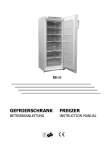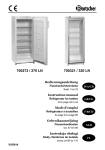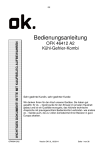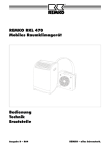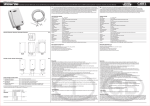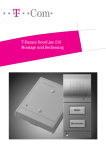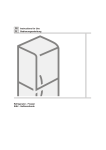Download BETRIEBSANLEITUNG INSTRUCTION MANUAL
Transcript
BETRIEBSANLEITUNG INSTRUCTION MANUAL WICHTIGE GEBRAUCHS UND SICHERHEITSHINWEISE LESEN SIE BITTE DIE GEBRAUCHSANWEISUNG SORGFÄLTIG DURCH ! Bei Nichtbeachtung der in der Gebrauchsanweisung genannten Anweisungen besteht die Gefahr der Beschädigung des Geräts und des damit verbundenen Verlusts des Rechts auf Garantieleistungen. Wir empfehlen ihnen, die Gebrauchsanweisung bis zum Ende der Betriebszeit aufzubewahren und sie im Falle eines Verkaufs des Geräts an den neuen Eigentümer weiterzugeben. ACHTUNG! Halten Sie die Lüftungsöffnungen im Gerategehäuse oder in Seitenwändenvon umgebenden Einbauwänden frei von Hindemissen. möglichen Benutzen Sie keine mechanichen Gegenstände order andere Mittel, um den Abtauprozess zu beschleunigen, ausser den vom Hersteller empfohlenen. Das Kühlsystem des Geräts nicht beschädigen. Verwendetes Kühlmittel R 600a. Falls das Kühlsystem beschädigt ist: Kein offenes Feuer verwenden. Funkenschlag vermeiden, keine elektrischen einschalten. Den Raum sofort durchlüften. sowie Beleuchtungsgeräte Kinder nicht mit dem Kühlschrank spielen oder ihn ans Netz anschließen oder den Stecker ziehen lassen. Kinder nicht mit der Verpackung spielen lassen. Verpackungsteile (z. B. Folien, Styropor) können für Kinder gefährlich sein. Erstickungsgefahr! Verpackungsmaterial von Kindern fernhalten. Diese Gerät ist nict dafür bestimmt durch Personen (einschließlich Kinder), mit eingeschränkten physischen, sensorischen oder geistigen Fähigkeiten oder mangels Erfahtung und/oder mangels Wissen benutzt zu warden, es sei denn sie warden durch eine für ihre Sicherheit zuständige Person beaufsichtigt order erhielten von ihr Anweisungen wie das Gerät zu benutzen ist. Falls der Kühlschrank sich in kühler Umgebung befunden hat (Außentemperatur weniger als +12 o C), diesen erst nach Ablauf von zwei Stunden ans Netz anschließen. Das Gerät nicht ans Netz anschließen ohne vorher alle Verpackungs- und Transportelemente entfernt zu haben. Bitte überprüfen Sie nach dem Auspacken des Geräts, ob alle Bestandteile vorhanden sind und ob Gehäuse und Kabel keine Beschädigungen aufweisen. Die Benutzung eines technisch nicht einwandfreien Geräts ist zu unterlassen. NETZANSCHLUSS Das Kühlgerät unbedingt an eine geerdete Steckdose anschließen. Die geerdete Steckdose für den Netzanschluss des Geräts sollte sich an gut zugänglicher Stelle befinden. VOR DEM AUFSTELLEN EIN DEFEKTES KABEL UNBEDINGT DURCH EIN NEUES VOM SELBEN TYP WIE DAS VOM HERSTELLER DES KÜHLGERÄTS VERWENDETE ERSETZEN, UM SCHADEN AN GESUNDHEIT UND EIGENTUM ZU VERMEIDEN. UM JEGLICHES RISIKO AUSZUSCHLIESSEN, DARF EIN SCHADHAFTES NETZKABEL NUR VOM HERSTELLER, DESSEN WARTUNGSMEISTER ODER EINER ENTSPRECHEND AUSGEBILDETEN PERSON AUSGEWECHSELT WERDEN. Das Verwenden von Verlängerungskabeln, Adaptern oder Mehrfachsteckdosen ist NICHT ZULÄSSIG. Netzspannung und -frequenz müssen mit den in Angaben in der Tabelle über die allgemeinen Eigenschaften des Kühlschranks übereinstimmen. Beachten Sie bitte beim Aufstellen des Kühlgeräts, dass dieser das Netzkabel nicht beschädigt. Nichts Schweres wie Kühlgeräte, Möbel oder andere Haushaltgeräte auf das Stromkabel stellen, um dieses nicht zu beschädigen. Andernfalls könnte dies zu einem Kurzschluss und zu einem Brand führen. Achten Sie darauf, dass die Rückwand des Kühlgeräts den Netzstecker nicht berührt oder letzterer in irgendeiner Weise beschädigt ist. Ein defekter Netzstecker kann zu einem Brand führen! NACH DEM AUSSCHALTEN DES GERÄTS (ZUR REINIGUNG, ZUM AUFSTELLEN AN EINEM ANDEREN PLATZ USW.) DIESES ERST NACH MINDESTENS 15 MINUTEN WIEDER ANS NETZ ANSCHLIEßEN. Das Kühlgerät nur zur Kühlung und Aufbewahrung von Esswaren verwenden. Vor der Reinigung das Gerät ausschalten und den Netzstecker aus der Steckdose ziehen. Das Gerät darf nicht verbrannt werden. Bitte keine elektrischen Geräte wie Mikrowellengeräte, Haartrockner, Bügeleisen, Wasserkocher und ähnliche auf den Kühlschrank stellen: Kunststoffteile könnten sich entzünden. NUR DER SERVICE-FACHMANN IST IMSTANDE, TECHNISCHE MÄNGEL ZU BEHEBEN. A C H T U N G ! DIE ABDECKUNG DER LED-BELEUCHTUNG NICHT ENTFERNEN. Wenn eine LED-Beleuchtung vorhanden ist darf diese im Falle eines Ausfalls/Defekts nur durch den autorisierten Kundendienst ausgewechselt/repariert werden. ENTSORGUNG VON ALTGERÄTEN Dieses Gerät ist ausgezeichnet lt. Vorgabe der Europäischen Entsorgungsvorschrift 2002 / 96 / EC -WEEE Sie stellt sicher, dass das Produkt ordentlich entsorgt wird. Durch die umweltfreundliche Entsorgung stellen Sie sicher, dass eventuelle gesundheitliche Schäden durch Falschentsorgung vermieden werden. Das Symbol der Tonne auf dem Produkt oder den Begleitpapieren zeigt an, dass dieses Gerät nicht wie Haushaltsmüll zu behandeln ist. Stattdessen soll es dem Sammelpunkt zugeführt werden für die Wiederverwertung von elektrischen und elektronischen Gerätschaften. Die Entsorgung muss nach den jeweils örtlich gültigen Bestimmungen vorgenommen werden. Für weitere Informationen wenden Sie sich an Ihre örtliche Behörde oder Entsorgungsfirma. Machen Sie ausgediente Altgeräte vor der Entsorgung unbrauchbar: • Ziehen Sie den Netzstecker aus der Steckdose. • Trennen Sie den Stecker vom Netzkabel. • Entfernen oder zerstören Sie evtl. vorhandene Schnapp-und Riegelschlösser. Dadurch verhindern Sie, dass sich spielende Kinder im Gerät einsperren (Erstickungsgefahr!) oder in andere lebensgefährliche Situationen geraten. Kinder können Gefahren, die im Umgang mit Haushaltsgeräten liegen, oft nicht erkennen. Sorgen Sie deshalb für die notwendige Aufsicht und lassen Sie Kinder nicht mit dem Gerät spielen. ALLGEMEINE DATEN Bei Ihrem Kühlgerät handelt es sich um einen Kühlschrank. Im der Kühlfach werden Frischprodukte aufbewahrt. DER KÜHLSCHRANK IST UMWELTFREUNDLICH, ER BEINHALTET KEINE DIE OZONSCHICHT SCHÄDIGENDEN MATERIALIEN: als Kühlmittel wird R 600a verwendet, die Isolierung Ihres Geräts besteht aus Zyklopentan C5H10. DER HERSTELLER GARANTIERT EINE ZUVERLÄSSIGE FUNKTION DES KÜHLSCHRANKS EINER VERHÄLTNISMÄSSIGEN LUFTFEUCHTIGKEIT VON BIS ZU 70 PROZENT UND BEI EINER UMGEBUNGSTEMPERATUR: VON +16 BIS +32 GRAD CELSIUS. Der Kühlschrank gehört der Klimaklasse N an. VON +16 BIS +43 GRAD CELSIUS. Der Kühlschrank gehört der Klimaklasse T an. Kühlgerät Kühlschrank Gesamtbruttovolumen, L 270 Nutzinhalt Gefrierteil, L 267 Der tatsächliche Verbrauch hängt von der Nutzung und vom Standort des Gerätes ab Energieeffiziensklasse Energieverbrauch: Klimaklasse kWh/24 h kWh/Jahr A+ A++ 0,377 138 0,285 104 N-T Geräuschemission dB(A) 1 pW Abmessungen, cm Elektrische Daten 41 145 x 60 x 62 145 x 60 x 65 siehe Typenschild Alle gerätespezifischen Daten des Energielabels sind durch den Gerätehersteller nach europaweit genormten Messverfahren unter Laborbedingungen ermittelt worden. Sie sind in der ISO EN 15502 festgehalten. Der tatsächliche Energieverbrauch der Geräte im Haushalt hängt natürlich vom Aufstellungsort und vom Nutzerverhalten ab und kann daher auch höher liegen als die vom Gerätehersteller unter Normbedingungen ermittelten Werte. Der Fachmann kennt diese Zusammenhänge und führt die Prüfungen mit speziellen Messgeräten nach den gültigen Normen durch. HERSTELLERANGABEN Der Hersteller behält sich das Recht vor, die in der Gebrauchsanweisung genannten technischen Eigenschaften des Gerätes sowie dessen Ausstattung zu ändern. Änderungen zur Verbesserung des Produktes vorbehalten. BESCHREIBUNG DES GERÄTS, HAUPTBESTANDTEILE 1 Temperaturregler 5 Kondensator 2 Ein-/Ausschaltknopf für die Innenbeleuchtung 6 Tauwasserverdunstungsgefäß Ablageflächen 7 Kompressor 3-4 VORBEREITUNG DES GERÄTS Wir empfehlen, für die Vorbereitungsarbeiten eine weitere Person heranzuziehen. Die Verpackung entfernen. ACHTUNG Entnehmen Sie das separate Styroporteil (Transportschutz) zwischen Geräterückwand und Kondenssator -Metallgitter (falls vorhanden). Den Kühlschrank von der Schaumstoffunterlage nehmen. Klebebänder entfernen. Neigen Sie beim Aufstellen den Vorderteil des Kühlschranks ein wenig nach hinten, dann können Sie ihn auf den Rädchen leicht an den gewünschten Platz rollen. Ist Ihr Kühlschrank mit angeschraubten Handgriffen ausgestattet, so beim Anheben und Verschieben des Kühlschranks bitte nicht auf Handgriffe zu nehmen, um ihren Abbruch zu vermeiden. Entfernen Sie alle roten Teile von den Ablageflächen (Abb. 2). Entfernen Sie die roten Klebebänder von den Türablagen, diese sind nur für den Transport erforderlich. A N M E R K U N G . Beim Öffnen der Gefrierschranktür fällt ein rotes Kleinteil heraus – DIESES WIRD NUR FÜR DEN TRANSPORT BENÖTIGT. Nehmen Sie die zwei Streben 1 und setzen Sie diese in die Führungen 2 im oberen Teil der Rückwand ein. Entsorgen Sie die Verpackungen fachgerecht. Verpackungsmaterial: Wellpappe / Pappe (überwiegend aus Altpapier) Formteile aus PS (geschäumtes, FCKW-freies Polystyrol) Folien und Beutel aus PE (Polyethylen) ifungsbänder aus PP (Polypropylen) WICHTIG. Achten Sie auf eine umweltgerechte Entsorgung. AUFSTELLUNG Stellen Sie den Kühlschrank in einem trockenen, gut gelüfteten Raum auf. A C H T U N G ! Der Kühlschrank darf nicht in ungeheizten Räumen oder auf dem Balkon betrieben werden. Das Gerät nicht in unmittelbarer Nähe einer Heizquelle (Kochherd, Heizkörper, direkte Sonneneinstrahlung) aufstellen. ACHTUNG! Der Kühlgerät darf nicht in Kontakt mit HeizungsGas- und Abwasserrohre geraten sowie elektrische Geräte nicht berühren. Die Lüftungsöffnung an der Oberseite des Kühlschranks darf nicht abgedeckt werden, eine ungehinderte Lufzirkulation muss gewährleistet sein. Der Zwischenraum zwischen der Oberseite des Kühlschranks und einem darüber befindlichen Möbel sollte mindestens 10 cm betragen. Andernfalls steigt der Stromverbrauch des Kühlschranks an oder der Kompressor kann sich überhitzen. Falls der Kühlschrank in einer Ecke aufgestellt werden soll, belassen Sie einen seitlichen Abstand von mindestens 6 mm Der Kühlschrank ist unbedingt auf einer ebenen Oberfläche aufzustellen, er darf nicht an die Wand angelehnt werden. Regulieren Sie, falls nötig, die Höhe durch Drehen der Stützfüße: durch Drehen im Uhrzeigersinn hebt sich der Vorderteil des Geräts, durch Drehen im Gegenuhrzeigersinn senkt er sich. Wenn der Kühlschrank ganz leicht nach hinten geneigt steht, gehen die Türen von selbst zu. TEMPERATURREGULIERUNG Die Temperatur im Kühlschrank wird durch Drehen des Temperaturdrehreglers eingestellt 1 (Abb. 1.). Die Zahlen auf dem Temperaturdrehregler zeigen die Temperatur an. Die Temperatur kann auf einer siebenteiligen Skala reguliert werden: 0 = der Kompressor wird abgeschaltet. ACHTUNG! Das Gerät ist noch am Stromnetz angeschlossen. 1 = höchste Temperatur (geringste Kühlung) 7 = niedrigste Temperatur (stärkste Kühlung) Falls die Produkte im Kühlfach zu kalt sein sollten, so stellen Sie bitte den Temperaturdrehregler auf Stufe 1, 2 oder 3 ein. Werden die Produkte im Kühlfach nicht genügend gekühlt, stellen Sie bitte den Temperaturdrehregler auf Stufe 4, 5 oder 6 ein. Bitte stellen Sie die Temperatur im Kühlschrank ganz nach Ihren Wünschen ein! DIE TEMPERATUR IM KÜHLFACH KANN ABHÄNGIG VON UMGEBUNGSTEMPERATUR, MENGE UND TEMPERATUR DER NAHRUNGSMITTEL, HÄUFIGKEIT DER TÜRÖFFNUNG SCHWANKEN. Deshalb empfehlen wir Folgendes: Stellen Sie den Kühlschrank möglichst nicht in der Nähe von Wärmequellen auf; Stellen Sie keine Esswaren in den Kühlschrank, die wärmer als die Umgebungstemperatur sind; Lassen Sie die Kühlschranktüren nicht offen stehen. Halten Sie die Kühlschranktüren nicht länger offen, als es für das Herausnehmen oder Hineinstellen der Produkte erforderlich ist. BEI NIEDRIGER RAUMTEMPERATUR KÜHLT DER KÜHLSCHRANK WENIGER STARK, DESHALB KANN DIE TEMPERATUR IM KÜHLSCHRANK ANSTEIGEN. Stellen Sie in diesem Fall die Temperatur mithilfe des Temperaturreglers niedriger. AUFBEWAHRUNG VON NAHRUNGSMITTELN IM KÜHLFACH Das Kühlfach ist zur kurzzeitigen Aufbewahrung von Frischprodukten bestimmt. Stellen Sie keine heißen Esswaren in den Kühlschrank, lassen Sie diese bis zu Zimmertemperatur abkühlen. Halten Sie sich an das vom Hersteller angegebene Haltbarkeitsdatum der Waren. ABTAUEN DER KÜHLKAMMER Die Kühlkammer taut automatisch ab. Die sich hinten in der Kühlkammer bildenden Eistropfen schmelzen während der Betriebspausen des Kompressors, das Schmelzwasser fließt durch die Tauwasserauffangrinne ins Tauwasserverdunstungsgefäß auf dem Kompressor und verdunstet dort. REINIGUNG UND PFLEGE REINIGEN SIE DEN KÜHLSCHRANK REGELMÄSSIG. Vergessen Sie nicht vor dem Abtauen oder dem Reinigen des hinteren Teils des Gehäuses das Gerät vom Netz zu nehmen. Bewahren Sie die Innenoberflächen des Geräts und alle Kunststoffteile vor Fett, Säure, Soßen. Falls Sie unabsichtlich davon ausgießen, reinigen Sie die betroffenen Flächen sofort mit warmem Seifenwasser oder Spülmittel. Reiben Sie sie anschließend trocken. Reinigen Sie die Innenflächen des Kühlschranks mit warmem Seifenwasser. Es kann auch Geschirrspülmittel verwendet werden. Reiben Sie die Innen- und Außenflächen trocken. Reinigen Sie die Türdichtung regelmäßig. Reiben Sie sie trocken. REINIGEN SIE REGELMÄßIG DIE ABFLUSSÖFFNUNG DER TAUWASSERAUFFANGRINNE MIT DEM DAFÜR VORGESEHENEN REINIGUNGSINSTRUMENT. Wischen Sie mindestens einmal im Jahr den Staub ab, der sich an der Kühlschrankrückwand und auf dem Kompressor angesammelt hat. Zur Reinigung eine weiche Bürste, elektrostatische Tücher oder den Staubsauger benutzen. Für die Innen- und Außenreinigung KEINE, körnigen, säure-, alkohol-, oder benzinhaltigen Putzmittel verwenden. Bei der Reinigung KEINE Scheuerlappen oder Schwämme mit rauer Oberfläche verwenden. PRAKTISCHE RATSCHLÄGE UND BEMERKUNGEN Bewahren Sie im Kühlschrank keine Bananen auf, denn diese Früchte sind kälteempfindlich. Bewahren Sie Esswaren mit einem spezifischen Geruch wie frischen Fisch, Gänseleberpastete, Käse in einem gut verschlossenen Behältnis auf. WENN SIE DAS KÜHLGERÄT FÜR LÄNGERE ZEIT AUSSCHALTEN, LASSEN SIE DIE TÜR OFFEN. Anmerkungen zum Betriebsgeräusch des Geräts. Die vom Kühlschrank während des Betriebs verbreiteten verschiedenen Betriebsgeräusche sind normal und deuten nicht auf einen Defekt hin. Das Plätschern, Gurgeln und Rauschen kommt vom Kühlmittel, das durch das Kühlsystem des Geräts zirkuliert. Ein kurzes, lauteres Aufheulen oder ein Klicken hört man, wenn der Kompressor des Geräts sich einschaltet. WECHSEL DES TÜRANSCHLAGS Zum Wechsel der Öffnungsrichtung der Kühlschranktür empfehlen wir eine weitere Person heranzuziehen. Sie brauchen: Schraubenschlüssel Nummer 8 und 10, Kreuzschraubenzieher. Der Kühlschrank darf zum Wechseln der Kühlschranktür NICHT horizontal abgelegt werden! Gehen Sie wie folgt vor: ACHTUNG! Schalten Sie das Gerät ab, ziehen Sie dazu das Netzkabel aus der Steckdose. 1. Entfernen Sie Abdeckleisten c von Gehäuse und Türinnenseite, nehmen Sie die obere Halterung 6 samt Unterlegscheiben mit aufgestülpten Unterlegscheiben und Kunststoffdichtung unter der Halterung ab. 2. Nehmen Sie die Kühlfachtür ab. 3. Nehmen Sie die die untere Abdeckleiste 1 ab. 4. Lösen die Achse 2 von unteren Halterung 7. Schrauben Sie es zusammen mit allen Scheiben zu an der anderen (gegenüberliegenden) Seite liegenden Halterung 7, symmetrisch der ehemaligen Stellung (siehe Abb.). 5. Setzen Sie die Gefrierfachtür auf den Tragstift von Halterung 7. 6. Drehen Sie Halterung 6 samt Tragstift, aufgestülpten Unterlegscheiben und Kunststoffdichtung um 180º. Drehen Sie den Tragstift samt Unterlegscheiben heraus und schrauben Sie ihn auf der anderen Seite der Halterung wieder fest. Setzen Sie Halterung 6 in der Kühlschranktür ein und schrauben Sie diese in die Öffnungen auf der Gegenseite des Kühlschranks fest. 7. Decken Sie die Halterung und die freien Öffnung mit den Abdeckkappen c ab. 8. Entfernen Sie die Schraubenabdeckkappen a und die Verschlussstopfen b. Drehen Sie die Schrauben der Türgriffe heraus. Schrauben Sie die Griffe auf der Gegenseite wieder fest. Die Verschlussstopfen drücken Sie in die verbliebenen Öffnungen in der Tür, die Abdeckkappen auf die Schrauben. 9. Entfernen Sie den Deckel 10 der unteren Abdeckung 1 und legen Sie es in die Leitschaufeln auf der anderen Seite der unteren Abdeckung (symmetrische Stellung des ehemaligen). Setzen Sie den linken und rechten Bein unterer Abdeckung 1 in die Löcher (siehe Bild.), und schieben Sie bis der Deckel einrastet. STÖRUNGEN UND DEREN BEHEBUNG Was, wenn... Der ans Stromnetz angeschlossene Kühlschrank nicht funktioniert. Überprüfen Sie, ob die Elektroinstallation bei Ihnen zu Hause in Ordnung ist. Überprüfen Sie, ob der Stecker richtig in die Steckdose gesteckt wurde. Der Lärmpegel des Geräts ansteigt. Überprüfen Sie, ob das Gerät stabil und waagrecht steht. Zur Regulierung bedienen Sie sich der vorderen Stützfüße des Geräts. Überprüfen Sie, ob zwischen dem Kühlschrank und anderen Möbeln oder den Teilen an der Hinterseite des Geräts und der Wand ein Zwischenraum ist. Ziehen Sie den Kühlschrank weg von den Möbeln oder der Wand. Überprüfen Sie, ob die lauteren Geräusche nicht von Flaschen, Dosen, Geschirr im Kühlschrank stammen, die sich gegenseitig berühren. Wasser auf dem Boden des Kühlfachs. Überprüfen Sie, ob die Abflussöffnung der Tauwasserauffangrinne nicht verstopft ist. Reinigen Sie die Abflussöffnung der Tauwasserauffangrinne mit dem dafür vorgesehenen Reinigungsinstrument. Wasser unter dem Kühlgerät. Das Tauwasserverdunstungsgefäß ist vom Kompressor gerutscht. Stellen Sie das Becken auf den Kompressor zurück. Beim Öffnen der Kühlschranktüren quillt das Gummidichtungsband hervor. Die Dichtung ist mit klebrigen Nahrungsmitteln (Fett, Sirup) verschmutzt. Reinigen Sie die Dichtung und die Vertiefung für die Dichtung mit warmem Seifenwasser oder Spülmittel, reiben sie beides trocken. Setzen Sie die Gummidichtung wieder in die Vertiefung ein. Hohe Temperatur im Kühlschrank, Betriebspausen des Kompressors kurz. Achten Sie darauf, ob die Kühlschranktüren sich gut dicht schließen lassen, ob nicht die Türen beim Herausnehmen oder Hineinstellen von Produkten länger als erforderlich offen gelassen wurden, ob nicht zu viele und zu warme Esswaren in den Kühlschrank gestellt wurden. Die Oberfläche des Kühlschranks beschlägt sich. Die Luftfeuchtigkeit in der Umgebung beträgt mehr als 70 Prozent. Lüften Sie den Raum, in dem das Kühlgerät steht, beseitigen sie falls möglich die Ursache für die Feuchtigkeit. TRANSPORT BEI NICHTBEACHTUNG DER TANSPORTVORSCHRIFTEN KANN DER HERSTELLER NICHT FÜR ENTSTEHENDE SCHÄDEN HAFTBAR GEMACHT WERDEN. Das Kühlgerät nur in vertikaler Lage transportieren. Während des Transports muss das Kühlgerät vor atmosphärischen Einwirkungen (Regen, Schnee, Feuchtigkeit) geschützt sein. Das Kühlgerät muss gut befestigt sein, um Verrutschen und Beulen durch Schläge während des Transports zu vermeiden. Falls das Gerät nicht in vertikaler Lage transportiert wurde, darf es erst nach mindestens vier Stunden ans Netz angeschlossen werden. Bei Nichtbeachtung dieser Vorschrift droht der Ausfall des Kompressors. GARANTIELEISTUNGEN FALLS IHR KÜHLSCHRANK NICHT MEHR RICHTIG FUNKTIONIERT, ÜBERZEUGEN SIE SICH, OB SIE DIE URSACHE DES NICHT ZUFRIEDENSTELLENDEN BETRIEBS DES GERÄTS NICHT SELBST BEHEBEN KÖNNEN. Können Sie das Problem nicht selbst lösen, wenden Sie sich telefonisch oder schriftlich an einen Serviceverteter in Ihrer Nähe. Geben Sie dabei unbedingt Modell (1) und Gerätenummer (2) an. Diese Angaben finden Sie auf der Geräteetikette an der linken Außenwand des Kühlfachs. IMPORTANT USE AND SAFETY INSTRUCTIONS CAREFULLY READ THE INSTRUCTION MANUAL. If instructions are not followed, there is a risk of injury, damage of the appliance and loss of the right to free warranty service. We recommend to keep the Instruction manual the whole time you have the appliance. When you sell the appliance pass the Instruction manual to the new owner of the appliance. – – – – – – – WARNING! Do not cover the ventilation holes at the top and on the sides of the appliance. Do not use any mechanical means or electrical devices to hasten the thawing process when cleaning the freezer compartment. Do not use electrical appliances inside the food storage compartments of the appliance, unless they are of the type recommended by the manufacturer. If the supply cord is damaged it must be replaced by the manufacturer, manufacturer service agent or a similarly qualified person, in order to avoid a hazard. Disposal of the appliance should be according to national rules. – Do not damage the appliance refrigeration system. It contains the refrigerant gas R600a. If the refrigeration system is damaged: Do not use any open flame. Avoid sparks ― do not turn on any electrical appliances or lighting fixtures. Immediately ventilate the room. Do not allow children to play with the appliance or to plug it in or unplug from the electricity supply socket. Do not allow children to play with the packaging material from the appliance. Packaging materials (e.g. plastic bags, polystyrene) are dangerous for children. Risk of suffocation! Keep packaging materials out of reach of children. The appliance should not be used by children or mentally challenged individuals, unless they have previously been shown how to operate the appliance by someone responsible for their safety. If the appliance is brought in from the cold (temperature is not higher than +12 °C), you should wait for two hours before connecting it to the mains. The appliance should not be connected to the mains until all packing and transport materials aren’t removed. Once the appliance is unpacked, make sure that it is complete, that the body and the electrical cord aren’t damaged. It is forbidden to use a technically damaged appliance. – – – – CONNECTION TO THE MAINS The appliance must be plugged into an earthed electricity supply socket. The earthed electrical socket by which the appliance is connected to the mains should be in an accessible place. IF THE APPLIANCE IS PRODUCED WITH THE SPECIAL SUPPLY CORD IT CAN BE EXCHANGED ONLY BY THE SAME SPECIAL SUPPLY CORD PROVIDED BY THE MANUFACTURER. TO AVOID HAZARDS, DAMAGED POWER SUPPLY CORDS SHOULD BE REPLACED ONLY BY THE MANUFACTURER, A MAINTENANCE TECHNICIAN, OR A PERSON WITH AN EQUIVALENT QUALIFICATION. DO NOT USE extension cords or connectors (adapters) or couplers. – – – The frequency and power of the electricity supply in your house must conform to the general data parameters of the appliance as it is shown in the product label. When positioning the appliance, be careful that the electrical cord isn’t squeezed in order to avoid its damage. Do not store heavy objects such as cooling devices, furniture or other domestic devices next the appliance in such a way that they could squeeze and damage the electrical cord. This can cause a short circuit and a fire. Make sure that the plug of the electrical cord is not squeezed by the back wall of the appliance or otherwise damaged. A damaged plug can be the cause of a fire! IF THE APPLIANCE IS UNPLUGGED (FOR CLEANING, MOVING TO ANOTHER PLACE, ETC.), IT MAY BE REPEATEDLY SWITCHED ON AFTER 15 MIN. The appliance should be used only for storing foodstuffs. The appliance can’t be disposed of by burning. Do not place any switched on electrical devices (such as microwave ovens, hair dryers, irons, electric kettles or other electrical devices) on top of the appliance because this may cause ignition of plastic parts. Do not place any dishes with liquids on top of the appliance and do not keep flowers in vases or other liquid-filled vessels on the appliance. Do not climb on or sit on the appliance, do not lean on or hang on the appliance doors and do not allow children to do this. IF THE APPLIANCE IS OUT OF ORDER AND IT IS NOT POSSIBLE TO REPAIR IT BY MEANS OF GIVEN RECOMMENDATIONS, UNPLUG IT, OPEN THE DOORS AND CALL THE SERVICE EXPERT. ONLY A SERVICE REPRESENTATIVE CAN REMEDY ALL TECHNICAL OR CONSTRUCTION FAULTS. WARNING! DO NOT OPEN THE COVER OF THE LED ILLUMINATION. In case that LED illumination is used the service representative must be contacted when the LED light is defected. DISPOSAL OF USED DEVICES This product is marked in accordance with the European waste regulation 2002 / 96 / EC -WEEE It regulates the proper disposal of the product. Environmentally friendly disposal will prevent possible negative consequences to health caused by improper disposal. This symbol on the product or its packaging indicates that this product must not be disposed of with the regular household waste. The user has to return the product to a collection point for the recycling of electric and electronic equipment. The disposal must comply with the local regulations in place. For further information please contact your local authorities or waste collection service. Disable waste equipment before disposal: • Disconnect the mains plug from the wall socket. • Disconnect the plug from the mains cable. • Remove or disable any existing spring or latch locks. This will prevent children from locking themselves (risk of suffocation!) or from getting into perilous situations. Children might not understand the risks that arise from handling household devices. Therefore, observe children and make sure they do not play with the device. GENERAL INFORMATION The appliance is a refrigerators made as a cabinet and designed for a short-term storage of chilled products. THE APPLIANCE IS ECOLOGICALLY CLEAN, CONTAINING NO MATERIALS HARMFUL TO THE OZONE LAYER: the refrigerant used is R600a, the foaming agent used for the appliance insulation is cyclopentane C5H10. THE MANUFACTURER GUARANTEES RELIABLE OPERATION OF THE REFRIGERATOR WHEN THE RELATIVE AIR HUMIDITY NOT GREATER THAN 70 PER CENT AND THE AMBIENT TEMPERATURE IS: +16 TO +32 DEGREES CELSIUS (Climate class N); +16 TO +43 DEGREES CELSIUS (Climate class T). Appliance Refrigerator Total gross volume, L 270 Net volume, L 267 Actual consumption will depend on how the appliance is used and where it is located Energy efficiency class Energy consumption: kWh/24h kWh/year A+ A++ 0,377 138 0,285 104 Climate class N-T Noise level, dB(A) re 1pw Overall dimensions, cm Electrical Data 41 145 x 60 x 62 145 x 60 x 65 see in the product label All device-specific data of the energy label have been determined by the manufacturer under laboratory conditions in accordance with pan-European standardized measuring methods. These are regulated by ISO EN 15502. The actual energy consumption depends on the usage and might therefore also be above the values determined by the manufacturer under standard conditions. An expert knows these relations and will execute the tests with special measurement instruments in accordance with the regulations in place. MANUFACTURER DATA The manufacturer reserves the right ti make future changes to technical parameters and specifications. Product is subject to changes and improvements. SCRIPTION OF THE APPLIANCE, BASIC PARTS (see fig.) 1 Thermostat - temperature regulator 5 Condenser 2 On / off switch for interior light 6 Thaw water drip tray 3 Adjustable height shelves 7 Compressor 4 Shelf PREPARING THE APPLIANCE FOR OPERATION It is recommended to prepare the appliance for operation with a helper ! Remove package. Remove the separate polystyrene part (transport protection) between the rear of the device and condenser – metal grid (if available). Lift the appliance away from foamed polystyrene base. Tear off adhesive tapes. When positioning the appliance in chosen location, it will move more easily into position if you lift the front a little and incline it backward, allowing it to roll on its casters. Your appliance is fit with screwed handles to not rise or push it taking by handles. Handles may break. Remove all red-coloured parts (see fig. 2) from the shelves. Tear away the red-coloured adhesive tapes – they are intended only for the transport of the appliance. Take two supports 1 from the bag (see fig.) and insert them into the guides 2 at the top back part of the appliance. Suitably dispose the packaging material. Packaging material: The packaging for transportation of the device and individual parts is produced of recyclable materials: corrugated cardboard / paperboard (mainly of waste paper) form part of PS (foamed, CFC-free polystyrene) Films and bags of PE (polyethylene) Strapping strips of PP (polypropylene) IMPORTANT. Make sure you dispose of packaging materials environmentally friendly POSITIONING Place the appliance in a dry, well ventilated room. W A R N I N G ! The appliance should not be operated in an unheated room or porch. Place the appliance away from heat sources such as kitchen stove/oven, radiators, or direct sunlight. WARNING! The appliance must not touch any pipes for heating, gas or water supply, or any other electrical devices. Do not cover the ventilation holes at the top of the appliances– it must be a good air circulation around the appliance. There should be a gap of at least 10 cm between the top of the appliance body and any furniture that may be above it. If this requirement is not followed, the appliance consumes more electrical energy and its compressor may overheat. If the appliance is placed in a corner, a gap of at least 60 mm must be left between the appliance body and the wall (see fig.) The appliance must stand on a level surface and must not touch the wall. If necessary, regulate the height of the appliance by adjusting the levelling feet: by turning them clockwise – the front of the appliance rises, by turning them counter clockwise – it comes down. If the appliance is tilted slightly backward – the doors will close by themselves. TEMPERATURE REGULATION The temperature in the refrigerator compartment is controlled using the thermostat knob 1 (fig. 1) by turning it to one side or the other. The temperature indication in digits is shown beside the thermostat knob. The temperature is regulated on the scale: 0 = Compressor is switched off. W A R N I N G ! Electric current is not switched off. 1 = highest temperature (lowest cooling) 7 = lowest temperature (highest cooling) If food products in the refrigerator compartment are too cold, set the thermostat knob to 1, 2 or 3. If food products in the refrigerator compartment are not being chilled sufficiently, set the thermostat knob to 4 or 5 - 7. Please set the desired temperature in the appliance according to your own requirements! THE TEMPERATURE IN THE REFRIGERATOR COMPARTMENT MAY VARY DEPENDING ON AMBIENT TEMPERATURE, THE AMOUNT OF FOODSTUFFS, THE TEMPERATURE OF THE FOODSTUFFS, AND HOW OFTEN THE APPLIANCE DOOR IS OPENED AND CLOSED. Therefore we recommend: locate the appliance away from heat sources, food placed in the appliance should not be warmer than the room temperature, appliance door must not to be left open, the appliance door should not be open longer than it is necessary to take out or put in foodstuffs. IF THE ROOM IS COOL, THE APPLIANCE COOLS LESS. THE TEMPERATURE IN THE APPLIANCE MAY THEREFORE RISE. Use the thermostat wheel to set a lower temperature. DEFROSTING OF THE REFRIGERATOR COMPARTMENT The refrigerator compartment defrosts automatically. Drops of ice that form on the back wall of the refrigeration compartment thaw during the time the compressor is not working and the thaw water runs down the thaw water runoff channel to the tray on top of the compressor, where it evaporates. CLEANING AND CARE REGULARLY CLEAN THE APPLIANCE. Remember that before cleaning the appliance body you must disconnect the appliance from the electrical energy supply socket by pulling the plug out of the electricity outlet. Clean the appliance inner surfaces with warm soapy water. Dishwashing detergent may also be used. Wipe dry inner and outer surfaces. Regularly clean the hermetic gaskets of the doors. Wipe dry. REGULARLY CLEAN THE THAW WATER CHANNEL SPACE WITH A SPECIAL CLEANER FOR THAT PURPOSE. At least once a year clean dust away from the back part of the appliance body and the compressor. A soft brush, electrostatic cloth or vacuum cleaner may be used for cleaning. DO NOT use detergents containing abrasive particles, acid, alcohol or benzene for cleaning the appliance inner and outer surfaces. DO NOT use for cleaning cloths or sponges that have coarse surfaces intended for scrubbing. PRACTICAL TIPS AND OBSERVATIONS Do not keep bananas in the refrigerator – these fruits are sensitive to cold. Do not keep prepared food and ready-to-cook (“heat and eat”) food in the same container. Store in an airtight container in the appliance any foodstuffs that have a strong odour (e.g. fresh fish, pâté de foie gras goose liver pâté, and cheese). IF THE APPLIANCE IS TO BE LEFT SWITCHED OFF FOR AN EXTENDED PERIOD, LEAVE ITS DOORS OPEN. R e m a r k s o n t h e a p p l i a n c e o p e r a t i n g n o i s e . As the appliance operates and goes through the freezing cycle, various noises will be emitted. This is normal and is not a sign of any malfunction. As the refrigerant circulates around the refrigeration system, it causes sounds like murmuring, bubbling, or rustling. Louder sounds like popping or clicking may be heard for a short time as the refrigerator’s compressor switches on. CHANGING THE OPENING DIRECTION OF THE DOORS It is recommended that changing the opening direction of the doors should be done with a helper. You will need two spanners No. 8 and No. 10 and a Philips head screwdriver. When changing the opening direction of the doors, YOU CAN NOT lay the refrigerator horizontally! Do the actions below in the order they are listed. W A R N I N G ! Turn off the appliance and pull the plug out of the electricity supply socket. 1. Remove the covers c from the body of the refrigerator and of the inner side of the door. Also remove the upper bracket 6 together with the nut and washers and the spacer under the bracket. 2. Remove the door of the refrigerator compartment. 3. Remove the bottom cover 1. 4. Unscrew the axle 2 from the bottom bracket 7 and put it together with all washers on the other cabinet side by screwing to the bracket 7 on the opposite side symmetrically to former position. 5. Hang the door on the axle 2 of bracket 7. 6. Turn bracket 4 around 180° together with the washers on the axle and the plastic spacer, transferring the washers to the axle on the other side of the bracket. Once the bracket is attached to the freezer compartment door, fix it in place on the other side of the refrigerator. 7. Turn the bracket 6 around 180° together with the washers on the axle and the plastic spacer. Remove the axle and the washers and reattach them on the other side of the bracket. Once the bracket 6 is attached to the refrigerator compartment door, fix it in place on the other side of the refrigerator in the uppermost apertures. Use the covers c to cover the bracket and the remaining space. 8. Remove the bolt covers a and the stoppers b. Remove the screws that hold the handle in place. Move the handle to the other side and screw them in place. Place the stoppers into the remaining apertures in the door, and put the screw caps in place. 9. Remove the cover 10 from the bottom cover 1 and insert it to the guides on the other side of the bottom cover (symmetrically to former position). Insert left and right legs of the bottom cover 1 (see pic.) and push it until cover fixing. OPERATION PROBLEMS AND THEIR SOLUTIONS (TROUBLESHOOTING) What if … The appliance is plugged in to the mains but it does not work. Check that your house electricity supply installations are in order. Check that the plug is correctly inserted into the electricity supply socket. The noise has become louder. Check that the appliance is standing stable, on a level place. To make it level, regulate the front feet. Check if the appliance is not touching any furniture, and that no part of the refrigeration system at the back part of the appliance body is touching the wall. Pull the appliance away from any furniture or walls. Check that the cause of increased noise isn’t due to bottles, cans or dishes in the appliance that might be touching each other. Water has appeared at the bottom of the refrigerator compartment. Check whether a thaw water channel space isn’t blocked. Clean the thaw water channel space with a cleaner intended for that purpose. Water has appeared under the appliance. The thaw water collection tray has slipped off the compressor. Place the tray on top of the compressor. When the appliance door is opened, the rubber sealing gasket pulls out. The gasket is smeared with sticky foodstuffs (fat, syrup). Clean the sealing gasket and the groove for it with warm water containing soap or dishwashing detergent and wipe dry. Put the rubber sealing gasket back into the place. High temperature in appliance, the compressor operation pauses are short. Ascertain whether the appliance door is shutting tightly, whether the door wasn’t kept open longer than necessary when taking out or putting in foodstuffs, or whether a large amount of warm food was placed in the appliance. The top of the appliance has condensation on it. The ambient relative air humidity is above 70 %. Ventilate the room where the appliance stands, and if possible remove the cause of the humidity. TRANSPORT THE MANUFACTURER WILL NOT BE RESPONSIBLE FOR ANY DAMAGE TO THE APPLIANCE THAT RESULTS FROM NON-COMPLIANCE WITH THE INSTRUCTIONS FOR TRANSPORTATION. The appliance should be transported in the vertical position. When being transported, the appliance should be protected from atmospheric conditions (rain, snow, dampness). The appliance should be firmly secured in place while being transported, to avoid slippage or any shocks in the transport vehicle. If the appliance was transported not vertically, it may be connected to the mains after 4 hours at least. If this is not done, the appliance compressor may fail. WARRANTY SERVICE IF YOUR APPLIANCE IS NOT WORKING PROPERLY, ASCERTAIN WHETHER YOU CAN REMEDY THE CAUSE OF THE FAULTY FUNCTIONING OF THE APPLIANCE YOURSELF. If you cannot solve the problem yourself, contact the nearest refrigerator service representative by telephone or in writing. When making contact, necessarily indicate the refrigerator model 1 and number 2. You will find this data on the product label, which is glued to the left wall of the refrigerator compartment. N00C2900-1




















